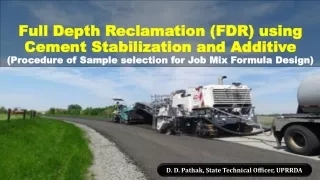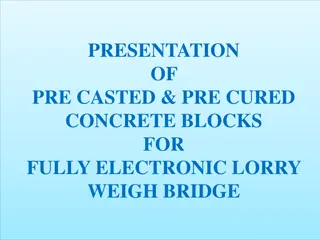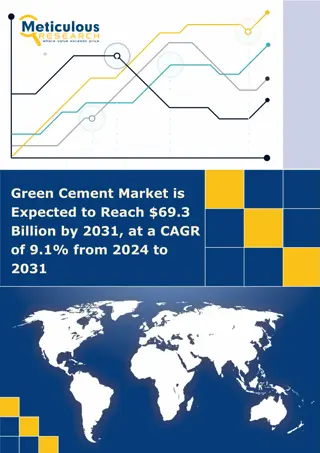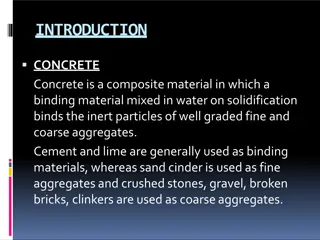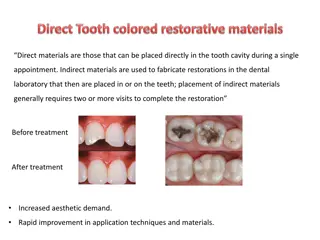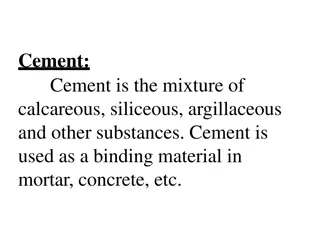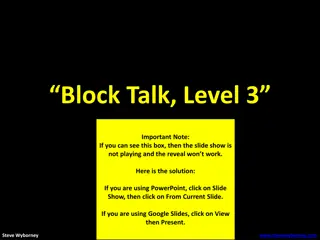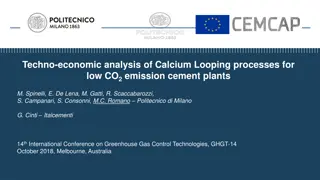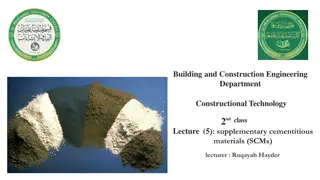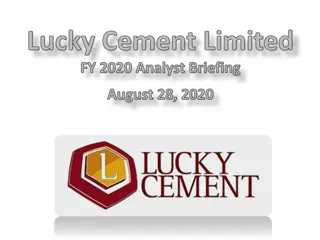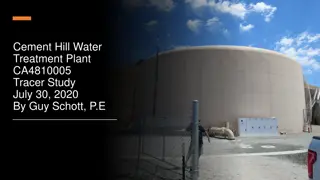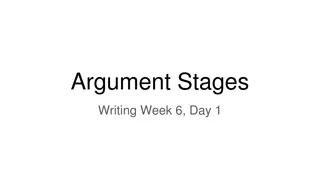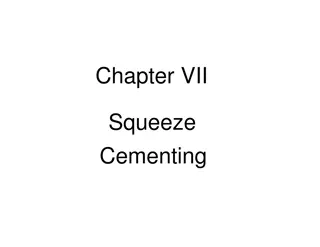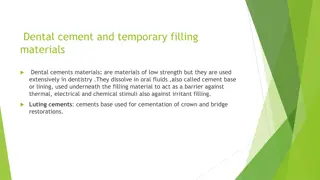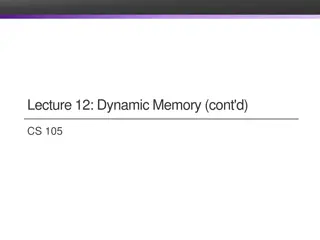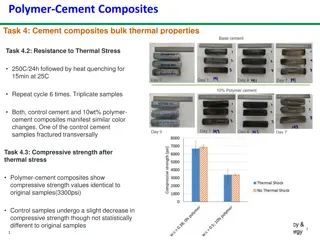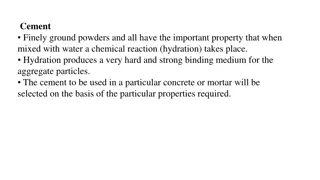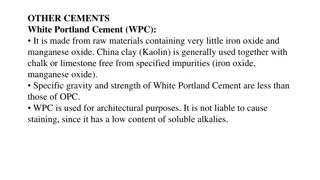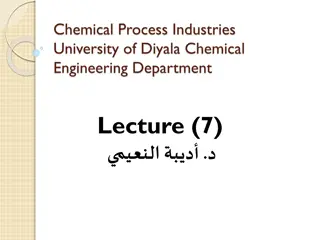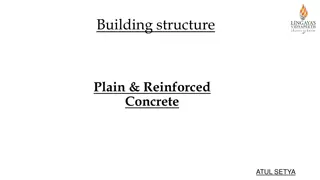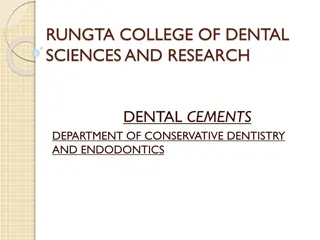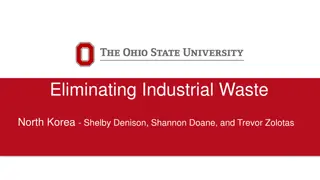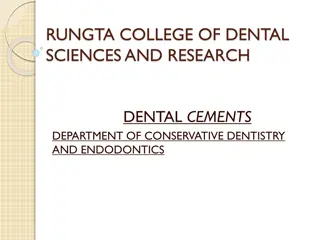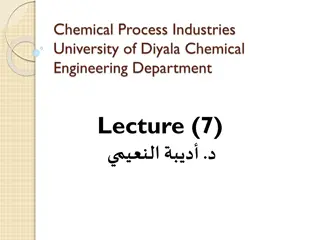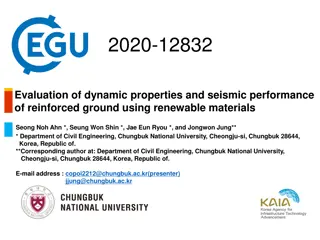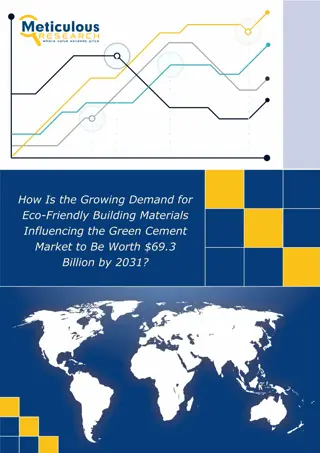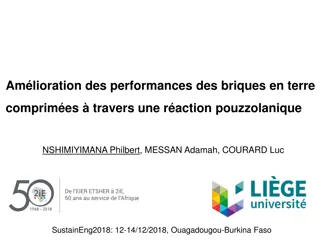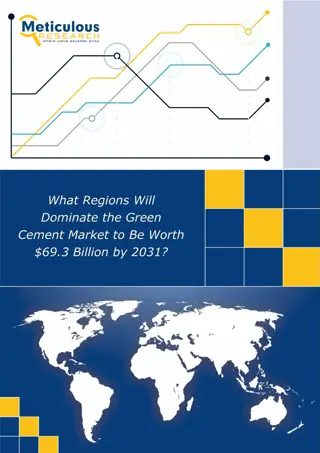Full Depth Reclamation (FDR) using Cement Stabilization and Additive
The procedure of selecting representative samples for the Job Mix Formula Design in Full Depth Reclamation (FDR) using Cement Stabilization and Additive. Understand the important principles and steps involved in sample collection.
6 views • 20 slides
Building blocks for organisation and role design
The building blocks for organisation and role design are crucial in developing a modern and integrated organisational structure. Key stakeholders from various teams such as Development, Health, Safety and Wellbeing, and Employee/Industrial Relations need to be involved for effective design. The invo
0 views • 7 slides
Information on Cement and Leading Cement Companies in Indonesia
Cement plays a crucial role in binding building materials together. Learn about the definition of cement, the history of cement production, and prominent cement companies in Indonesia like Semen Indonesia, PT Cemindo Gemilang, and Holcim Indonesia.
4 views • 74 slides
Innovative Pre-Casted & Pre-Cured Concrete Blocks for Lorry Weigh Bridge
Revolutionize your construction projects with pre-casted and pre-cured concrete blocks designed for fully electronic lorry weigh bridges. These blocks offer advantages such as easy installation, no need for foundation construction, and time-saving features. Explore images and learn more about this a
0 views • 13 slides
Green Cement Market is Expected to Reach $69.3 Billion by 2031
Green Cement Market Size, Share, Forecast, & Trends Analysis by Material (Fly Ash, Slag, Recycled Aggregate, Other Materials), End User (Residential, Commercial, Public Infrastructure, Industrial), Geography - Global Forecast to 2031\n
0 views • 5 slides
Operating System: File Allocation Methods
File allocation methods in operating systems determine how files are stored in disk blocks. The main methods include Contiguous Allocation, Linked Allocation, and Indexed Allocation. Contiguous Allocation involves allocating blocks in a contiguous manner for efficient disk space utilization and fast
0 views • 14 slides
Understanding Concrete: Types, Uses, and Classification
Concrete is a composite material composed of binding materials, water, and inert particles. It is classified based on binding materials, design, and purpose. Cement concrete is widely used in construction for its strength and durability, while lime concrete offers an economical alternative where cem
1 views • 48 slides
Key Insights on Preventive Adhesive Restoration in Dentistry
This article covers the concept of preventive adhesive restoration (PAR) in dentistry, involving techniques like visual examination, laser fluorescence, and radiographs for diagnosing caries. It discusses early interventions such as balancing oral environment, plaque cleaning, and remineralization,
1 views • 20 slides
Understanding File System Performance and Optimization Techniques
This content covers important topics related to file systems, such as improving system performance, preventing internal fragmentation, selecting block sizes, and organizing data blocks. Various file system case studies are discussed, including FFS and LFS, along with key concepts like super blocks,
0 views • 63 slides
Evolution of Dental Restorative Materials: From Silicate Cement to Composite Resins
Various dental restorative materials have evolved over the years, from silicate cement to composite resins. Silicate cement, introduced in 1871, offered advantages like matching tooth color but had drawbacks such as dental pulp irritation. Unfilled acrylic polymers, developed around 1945, showed imp
2 views • 11 slides
Guidelines for Design of Cement Concrete Pavement and Interlocking Paver Blocks
This document provides guidelines for designing cement concrete pavements and interlocking paver blocks, covering factors governing design, wheel loads, design period, subgrade characteristics, approximate k values based on CBR values, and the importance of a sub-base below concrete pavements. It em
0 views • 67 slides
Overview of Cement: Types, Composition, and Functions
Cement is a vital building material consisting of various compounds like lime, silica, and alumina. It is used in mortar and concrete. The chemical composition of cement includes elements like iron oxide and gypsum. Different types of cement serve specific purposes such as rapid hardening or sulfate
0 views • 29 slides
Esti-Mystery Challenge: How Many Blocks in the Vase?
Engage in the Esti-Mystery challenge to determine the number of blocks in the vase by deciphering clues that lead you to a final estimate. With each clue, narrow down the possibilities and refine your estimation skills until you reach the reveal of 63 blocks. Test your logical thinking and numerical
0 views • 6 slides
Understanding Unit Costing in Industries
Unit costing is a method based on production units and is used in industries with continuous and uniform production of a single product or similar grades. The cost per unit is calculated by dividing the total cost incurred by the number of units produced. Various industries like collieries, quarries
2 views • 18 slides
Techno-Economic Analysis of Calcium Looping Processes for Low CO2 Emission Cement Plants
This study explores the application of Calcium Looping (CaL) processes in cement plants to reduce CO2 emissions. The process involves using CaO as a sorbent to capture CO2 from flue gas, with the potential for integration at different points in the cement production process. The Tail-end CaL configu
3 views • 14 slides
Shader Fundamentals: Compiler Control and Global Options
Understanding how shaders are compiled with optimization control using pragma directives, managing shader processing in extension blocks, organizing shader variables into blocks, specifying uniform blocks, and controlling layout with qualifiers.
0 views • 20 slides
Sustainable Building Practices: Using Supplementary Cementitious Materials
Supplementary Cementitious Materials (SCMs) are waste and by-product materials that can be used as full or partial substitutes for cement in concrete production. This practice helps reduce the environmental impact of traditional cement manufacturing processes and improves the overall sustainability
0 views • 18 slides
Lucky Cement Limited FY 2020 Analyst Briefing Highlights
Lucky Cement Limited's FY 2020 Analyst Briefing highlights key figures, such as revenue growth, operating profit reduction, and sales quantity in the cement sector. Despite challenges like COVID-19, the company shows resilience with strategic investments and developments.
3 views • 13 slides
Green Cement Market
The Green Cement Market is Forecasted to Achieve $69.3 Billion by 2031, with a 9.1% CAGR between 2024 and 2031.\n
0 views • 4 slides
Tracer Study Summary at Cement Hill Water Treatment Plant
A tracer study was conducted at the Cement Hill Water Treatment Plant in CA to analyze the flow of liquid fluoride through the pipeline and storage tanks. The study involved injecting liquid fluoride into the transmission pipe post-filtration and measuring doses at different stations along the pipel
0 views • 29 slides
Discovering Dots with Beetle Geometry Module Investigation
Explore the world of Beetle Geometry in Module 2 Investigation 3, where you will discover how to draw dots and dashes using coding blocks. Experiment with creating your own dot and dash blocks to draw intricate patterns like dotted lines and circles. Enhance your skills by combining dot and dash blo
0 views • 25 slides
Importance of Putting Away Bristle Blocks for Safety and Organization
In a series of slides addressed to Lina, the importance of putting away Bristle Blocks after playtime is emphasized. The blocks, being pointy, can cause harm if left out. Instances of injury and frustration due to untidiness are highlighted, urging Lina to clean up for safety and organization. The s
0 views • 10 slides
Impregnation of Asbestos Cement Sheeting with Polyurethane Binder
The report discusses the successful impregnation of asbestos cement sheeting with a polyurethane binder to bond and reinforce the material. Through a method involving dye adduct formation and optimization of impregnation levels, the exposed asbestos fiber was effectively bonded. The process ensures
0 views • 6 slides
Well Cementing Procedures in Oil and Gas Industry
Learn about the important procedures involved in well cementing for remedial repair, cement squeezing at different pressures, packer operations, and water loss control using low water loss cement. Understand the steps involved in pump cementing under pressure, successful high-pressure squeezes, and
0 views • 23 slides
Understanding Dental Cements and Temporary Filling Materials
Dental cements are essential in dentistry, acting as barriers against various stimuli and irritants. They can be classified based on different compounds and have specific applications such as root canal sealers and orthodontic bonding. Zinc phosphate cement is a common material used for lining, whil
0 views • 24 slides
Dynamic Memory Allocation Strategies in CS
Dynamic memory allocation in CS aims to efficiently provide and recycle memory in the heap for running programs. Key goals include high throughput and memory utilization while minimizing fragmentation. Challenges involve determining how much memory to free, tracking free blocks, selecting blocks for
0 views • 26 slides
Study on the Thermal and Chemical Properties of Polymer-Cement Composites
The study investigates the resistance of polymer-cement composites to thermal stress and chemical attacks such as acidic and high CO2 environments. Results show similar color changes in control cement and polymer-cement composites after thermal stress, with the latter maintaining compressive strengt
0 views • 5 slides
Understanding Different Types of Cement for Construction
Cement is a crucial component in concrete and mortar, with various types available based on specific project requirements. Types include Ordinary Portland Cement for general construction, Modified Portland Cement for sulfate resistance, High Early Strength Cement for quick setting, Low Heat Portland
0 views • 5 slides
Saveh Cement Company: Business Plan Presentation Overview
Saveh Cement Company, a leading cement producer and exporter in Iran, aims to enhance energy efficiency, increase production rates, and reduce CO2 emissions through innovative projects. Established in 1988, the company boasts a strong market presence, high-quality products, and international certifi
0 views • 9 slides
Understanding Different Types of Cement
White Portland Cement (WPC) is ideal for architectural use due to its low iron and manganese oxide content, while High Alumina Cement (HAC) offers rapid hardening and sulfate resistance. Portland Pozzolan Cement provides greater sulfate attack resistance and is suitable for marine and hydraulic cons
0 views • 5 slides
Overview of Cement Industry: Processes and Classification
The lecture from the Chemical Engineering Department at the University of Diyala delves into the chemical process industries, focusing on the Cement Industry. It covers the properties of cement, raw materials required, the process of making concrete using Portland cement, and the classification of v
0 views • 10 slides
Understanding Plain & Reinforced Concrete Structures
Concrete is a vital construction material, with Plain Cement Concrete (PCC) and Reinforced Cement Concrete (RCC) being common types. PCC lacks reinforcement and is strong in compression but weak in tension. On the other hand, RCC combines concrete with steel reinforcement for improved tensile streng
0 views • 10 slides
Dental Cements in Conservative Dentistry and Endodontics
Learn about various types of dental cements used in conservative dentistry and endodontics, including zinc silicophosphate, resin cements, copper cement, and zinc oxide-eugenol cement. Understand their compositions, properties, classifications, and ideal requirements for different dental application
0 views • 18 slides
Sustainable Solutions for Industrial Waste Management
Industrial waste poses environmental challenges, but innovative approaches such as reusing waste, developing eco-friendly cement blocks, and incorporating by-products like recycled concrete aggregates offer promising solutions to reduce waste and emissions. These methods help create a more sustainab
0 views • 16 slides
Understanding Zinc Polycarboxylate Cement in Dental Sciences
Zinc polycarboxylate cement is an adhesive luting agent used in dentistry for various applications like luting permanent restorations, bases, and liners. It consists of zinc oxide powder and a liquid solution of polyacrylic acid. This cement sets through a reaction between the powder and liquid, for
0 views • 14 slides
Evolution of Concrete in the Chemical Process Industries
Cement and concrete have a rich history dating back thousands of years. Cement was used by ancient civilizations like the Egyptians, Assyrians, Babylonians, and Romans. Concrete, which is a mixture of aggregates bonded by cement and water, revolutionized architecture during the Roman Empire. The int
0 views • 12 slides
Evaluation of Dynamic Properties and Seismic Performance of Reinforced Ground Using Renewable Materials
Improvement of seismic performance through improved dynamic properties of ground using renewable materials like cement and biopolymer is crucial for reducing earthquake-induced structural damage. This study conducted resonant column tests to assess the enhanced dynamic properties of soil and utilize
0 views • 9 slides
Green Cement Market
The global Green Cement Market is expected to hit $69.3 billion by 2031, with a CAGR of 9.1% starting in 2024. The market's growth is being propelled by advancements in sustainable construction technologies and materials.\n
0 views • 3 slides
Improving Performance of Compressed Earth Blocks Through Pozzolanic Reaction
Enhancing the strength and durability of compressed earth blocks for modern construction using chemical stabilization methods involving materials like calcium carbide residue and rice husk ash. Experimental approaches and raw material processing are detailed in the study, focusing on binder addition
0 views • 18 slides
Green Cement Market
By 2031, the Green Cement Market is projected to reach $69.3 billion, with a CAGR of 9.1% from 2024. Dive into the trends and breakthroughs driving the evolution of construction materials.\n
0 views • 3 slides
